Custom Models screen
To access the Custom Models screen, navigate to the megamenu and click Models > Custom Models.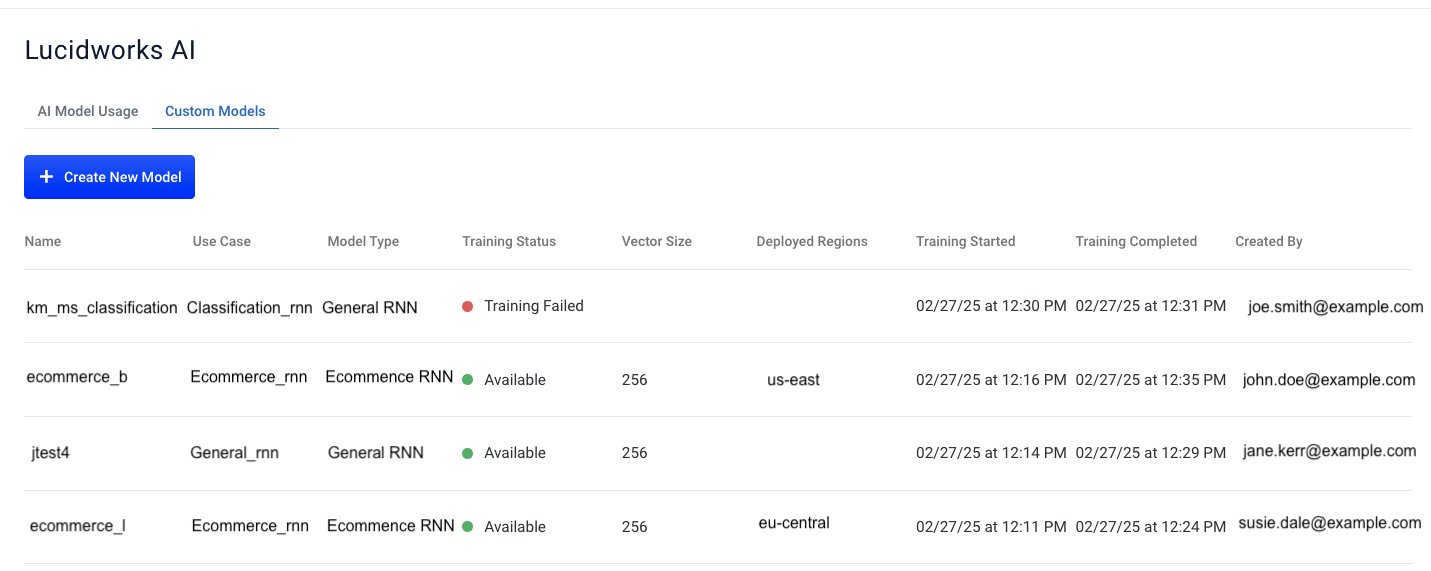
| Field | Description |
|---|---|
| Name | The name of the model. |
| Use case | The model use case used to train the model. |
| Training status | Also referred to as state, this is the current status of the model. Options are: , , , , . |
| Vector size | The number of elements and objects in the custom model. |
| Deployed regions | The geographic region specified when the custom model is deployed. |
| Training started | The date and time the training started. |
| Training completed | The date and time the training completed. |
| Created by | Also referred to as Author, this is the user who created the model. |
You can also create a new custom model. For more information, see Create a new model.
Model Details screen
If you hold the pointer over a model on the list and click the entry, the Model Details screen displays. You can view Training details that include Metadata, Summary, and Metrics information about the selected model. You can also:- Click Download Model Data to download the JSON file for the model. You can use the parameters from this model in a different model without rekeying the information.
- Click Delete if the model can be deleted. If the model cannot be deleted because it is associated with deployments, all the deployments must be deleted first. For example, if the model is associated with two deployments,
2 Active Deployments: Deleting Disableddisplays instead of the Delete button. This example indicates there are two current deployments for the model, and based on the status of those deployments, the option to delete the model is disabled.
Training Details
The Training Details screen provides metadata, summary, and metrics information.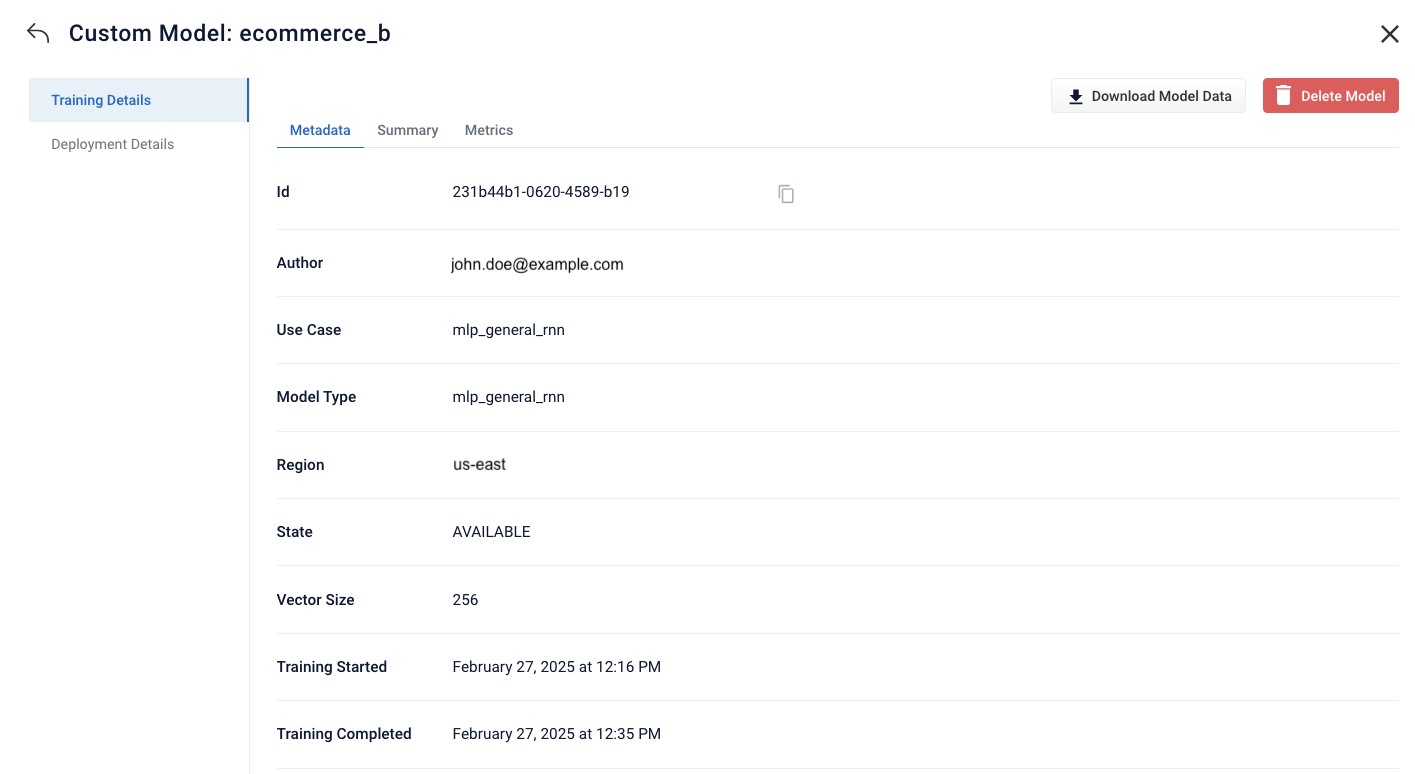
Metadata
This metadata provides the data supplied when the model was created.| Field | Description |
|---|---|
| id | The unique identifier for the model. The identifier of the model. For custom models, the value is the universally unique identified (UUID) that is the primary key for the model. |
| Author | Also referred to as createdBy, this is the user who created the model. |
| Use case | The model use case used to train the model. |
| ModelType | The model type. For custom models, it is the name of the model. |
| Region | Also referred to as Deployed region this is the geographic region specified when the model was trained. |
| State | Also referred to as Training status, this is the current status of the model. |
| Vector size | The number of elements and objects in the custom model. Default value is 256. |
| Training started | The date and time the training started. |
| Training completed | The date and time the training completed. |
| Training Data Index Catalog | The location of the catalog of the training data in Google Cloud Storage (GCS). |
| Training Data Query Signals | The location of signals in the training data in Google Cloud Storage (GCS). |
| Error Message | The errors generated when the training failed. This field only displays for custom models with a TRAINING_FAILED status. |
| dataset_config | The options for the dataset format used for training are mlp_general (used for the general RNN model type) and mlp_ecommerce (used for an ecommerce RNN model type). |
| trainer_config | The options for the trainer type used for training are mlp_general_rnn and mlp_ecommerce_rnn. |
| Additional dataset_config parameters | Any additional fields used to train the model using the Manual Entry method are listed. They are custom parameters. |
| trainer_config/text_processor_config | This field determines which type of tokenization and embedding is used as the base for the RNN model. This field only displays for custom models with a TRAINING_FAILED status. For more information, see Lucidworks AI Models API text processors. From that topic, select View API specification for detailed API information. |
| trainer_config.encoder_config.rnn_names_list | This field determines which bi-directional RNN layers are used. Options include gru and lstm. This field only displays for custom models with a TRAINING_FAILED status. |
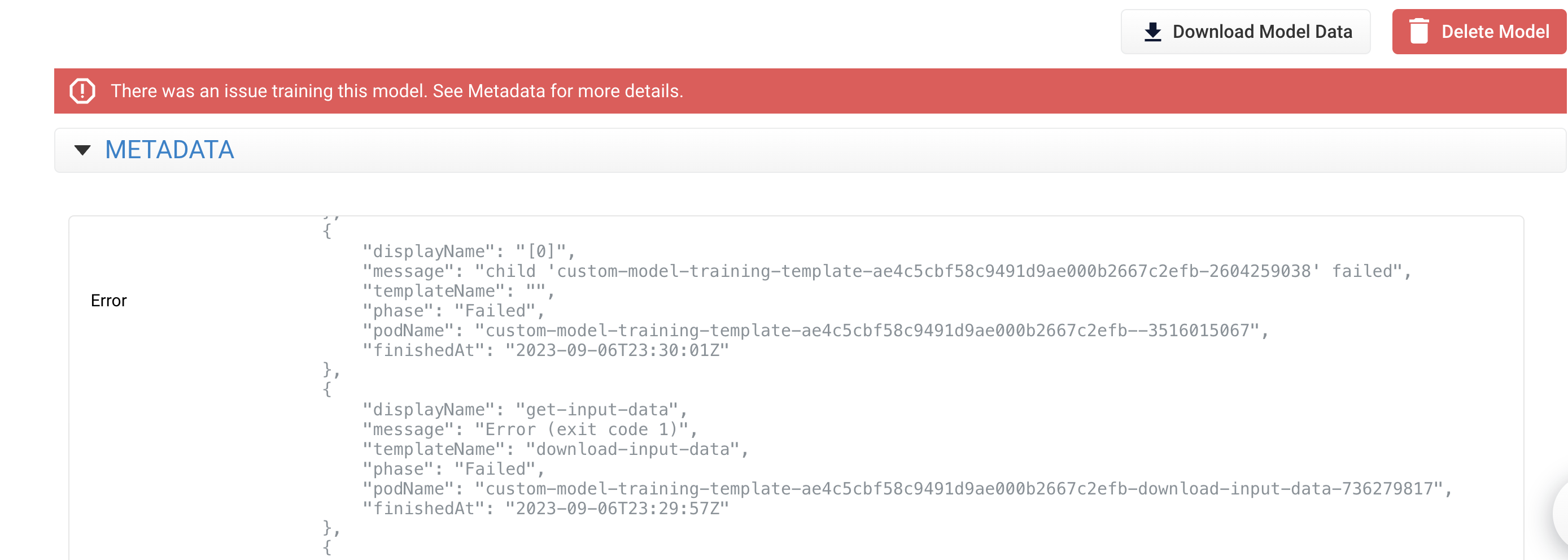
Summary
Click the Summary tab to view information about training metrics for the selected model.
| Field | Description |
|---|---|
| Best Epoch | The number of the epoch where the most relevant results were returned. |
| Index Size | The number of bytes in the vector index. |
| Vector size | The number of elements and objects in the custom model. |
| Training Time | The number of seconds to successfully train the model. |
| Num Trn Queries | The number of unique training queries used in this model. |
| Num Val Queries | The number of unique validation queries used in this model. |
| Num Unique Training Pairs | The number of unique training pairs for this model. An example of a training pair is query/document. This value may be larger than the Num Trn Queries because one query might return many documents, and therefore, many pairs. |
Metrics
Click the Metrics tab to view analytics about the trained model. This information provides insights that help you determine if parameters need to be changed or if more data is needed to improve the model for optimal results. The Custom configuration parameter that specifies metrics isdataset_config.metrics_config.monitor_metric. When you select one of the values, the k designates the numbers 1, 3, 5, and 10.
hit@kwhich measures the probability that the prediction is in the first topkmodel predictions.map@kis the mean average precision metric that evaluates the system to return relevant items in the topkresults, and positions more relevant items at the top.mrr@kis the mean reciprocal rank that determines how quickly the system displays the first relevant item in the topkresults.ndcg@kis the normalized discounted cumulative gain metric that compares rankings to the optimal order where all relevant items display at the top.recall@kdisplays the number of relevant items returned in the topkrecommendations out of the number of relevant items in the dataset.
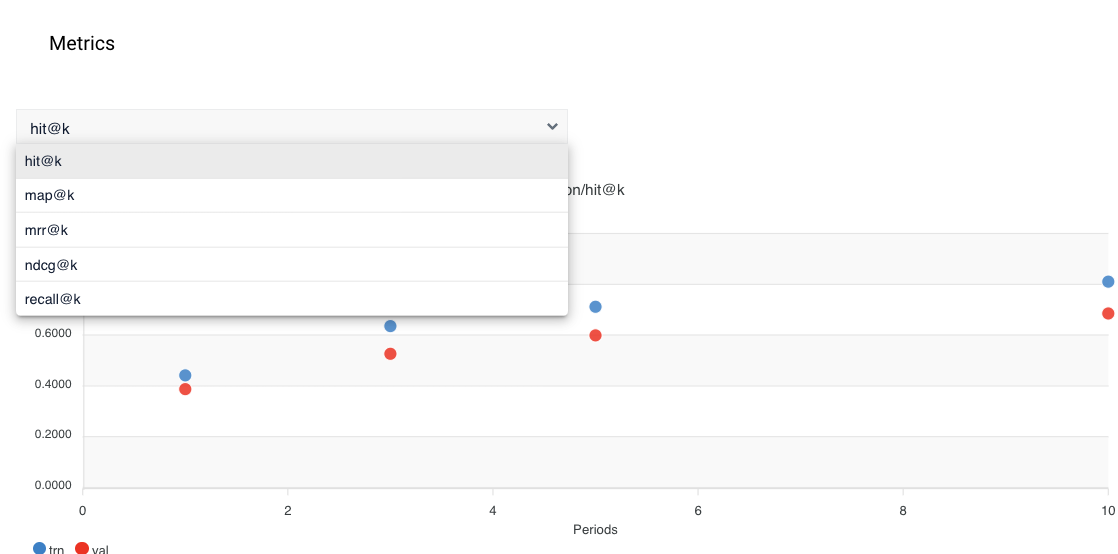
hit@k value is selected. Four graphs display on the screen: hit@1 (pictured), hit@3, hit@5, and hit@10.
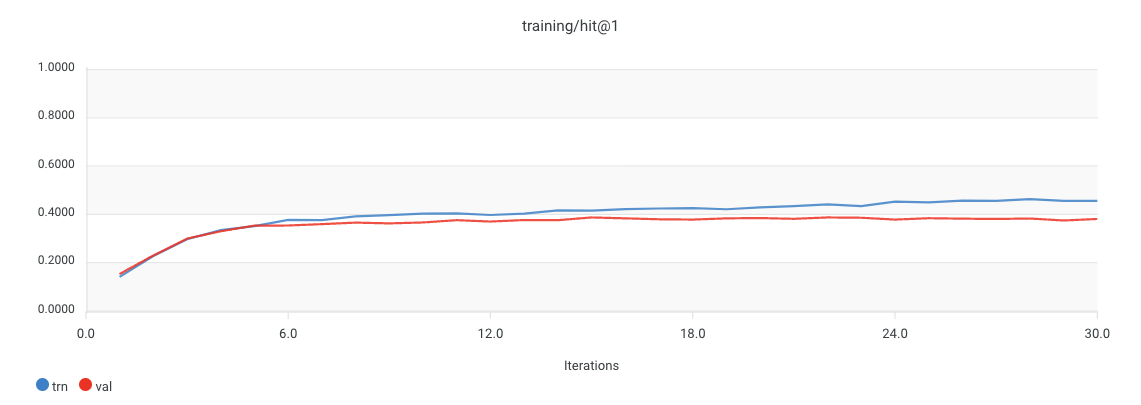
Deployment Details
The deployments screen displays information about each time you deployed the selected model.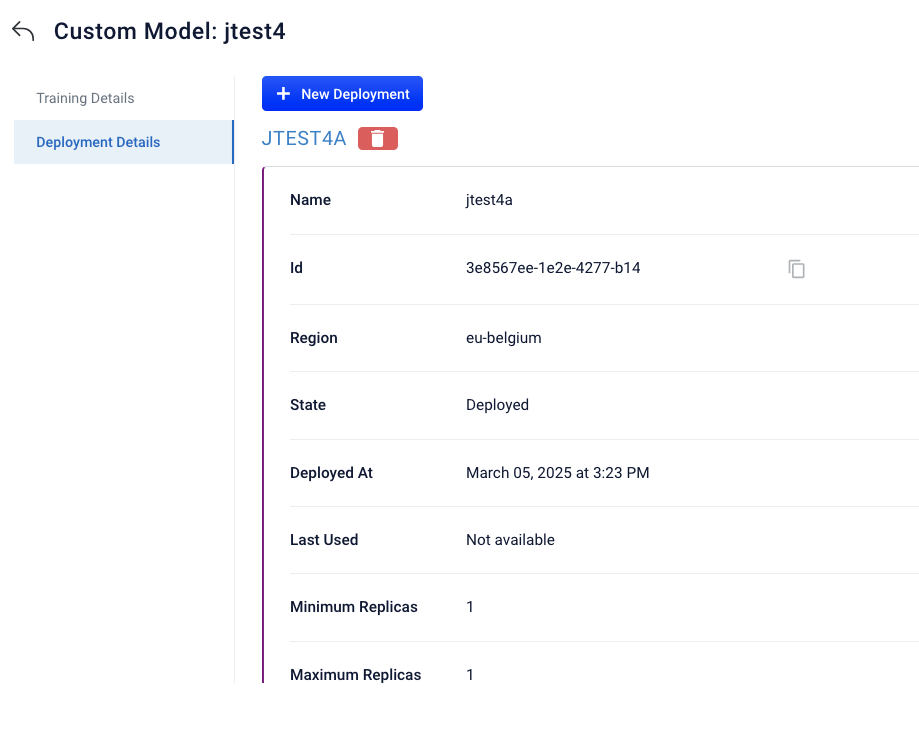
| Field | Description |
|---|---|
| id | The unique identifier for the model. For custom models, the value is the universally unique identified (UUID) that is the primary key for the model. |
| Region | The geographic region specified when the model was deployed. |
| State | The current status of the deployed model. Options are: This field specifies the current status of the custom model deployment. Value options include: * DEPLOYING. The model is in the process of being deployed. * DEPLOYED. The model is deployed and available for predictions. * DEPLOY_FAILED. The model failed to deploy. * DELETING. The model deployment is being deleted. The custom_model_deployment record is also deleted if the deployment is successfully deleted. * DELETE_FAILED. The model deployment deletion failed. The model is still deployed and available for predictions. |
| Deployed At | The date and time the deployment occurred. |
| Last Used | The last date and time this model was used in the /predict endpoint. |
| Minimum Replicas | The minimum value of replicas for the model. |
| Maximum Replicas | The maximum value of replicas for the model. |
| parameter_1 | The value of the first parameter passed in the config object. This parameter is optional. The name of parameter_1 is an example placeholder. The actual name of each custom configuration field is designated by the person creating the query. |
| parameter_2 | The value of the second parameter passed in the config object. This parameter is optional. The name of parameter_2 is an example placeholder. The actual name of each custom configuration field is designated by the person creating the query. You can use as many custom configuration fields as needed, it is not limited to the two fields mentioned. |
- Click + New Deployment to deploy the model again. For more information, see Create a new deployment.
- Click the Trash icon to delete a deployment with a status of “Deployed”. You cannot delete a deployment with a status of “Deploying”.